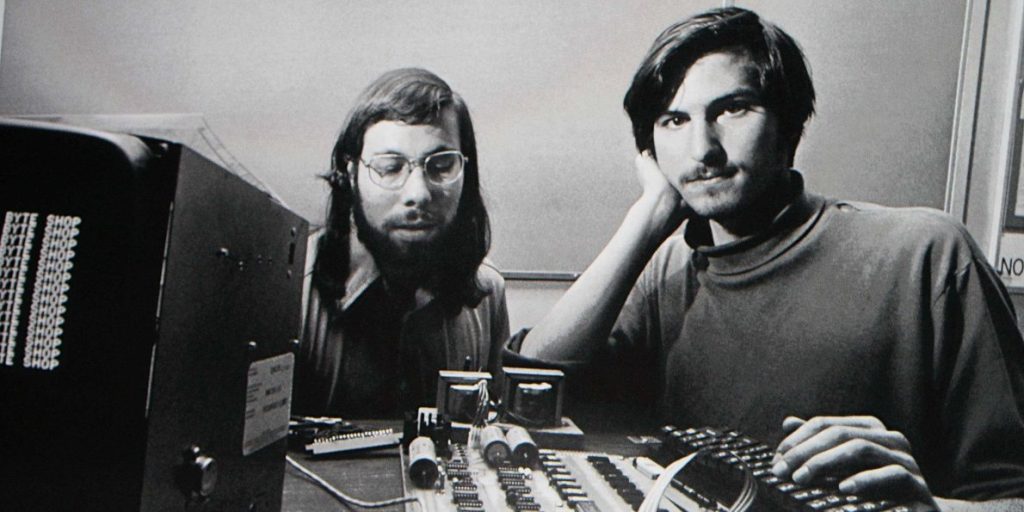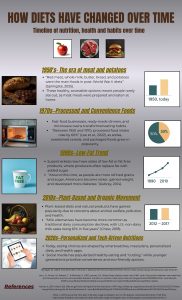Winner of the Fall 2017 StMU History Media Award for
Best Article in the Category of “People”
It was a sunny summer day. A sea of graduates, proud parents, family members, and faculty had their sights fixed on a bony and haggard individual. It seemed age had already taken possession of his body, making him look somewhat fragile and weak. Yet, he radiated forcefulness. The man was none other than Steve Jobs, ready to deliver Stanford’s Class of 2005 Commencement Speech. By that year, Jobs had gone through many hardships—he had been fired from the company he started, and he had undergone intricate medical procedures due to pancreatic cancer, just to name a few. Amidst the tragedies in his life, he transmitted nothing but the serenity of a man that had accomplished what he desired in life. One of his initial remarks was “Your work is going to fill a large part of your life, and the only way to be truly satisfied is to do what you believe is great work. And the only way to do great work is to love what you do. If you haven’t found it yet, keep looking. Don’t settle. As with all matters of the heart, you’ll know when you find it.”1 However, how exactly did Jobs find his dream job? Specifically, what was the genesis of Apple Inc?

“I did go to college… [and] after six months, I couldn’t see the value in it. I had no idea what I wanted to do with my life and no idea how college was going to help me figure it out.”4 In his academic hiatus, Steve encountered many things. He experienced psychedelic drugs, and sought to find spiritual enlightenment in India. He rekindled a friendship that would later serve as catalyst for the creation of the most powerful electronic company of all time, Apple Inc. His friend was Steve Wozniak, a talented, self-taught electronics engineer, whom Jobs had met in his high school years through common friends.5 Like himself, Steve Wozniak was an electronics enthusiast. After having part-time jobs with Atari and Hewlett-Packard, Jobs had found his passion—anything electronics.6 “I was lucky—I found what I loved to do early in life.”7 The two Steves, in love with computers, began their first commercial venture in 1975, when Jobs was only twenty years old.8
Their first creations were called “blue boxes”—electronic boxes that allowed anyone to make cost-free long-distance phone calls.9 Jobs invested $40 in parts and sold the boxes door-to-door in college dorm rooms for $150 apiece, splitting the profits with Wozniak.10 Although their first creation had to be shut down because of its illicit intentions, it proved that the two Steves were perfect business partners. Many attribute Apple’s early success to the natural connection the two Steve’s shared. Wozniak has commented,”we had so much in common. Normally, it was hard for me to explain to people the kind of designs I worked with, but Steve got it right away.”11 Similarly, Jobs explained, “He was the only person I met who knew more about electronics than me.”12 Despite their different personalities, they complemented each other in a wonderful manner. Steve Wozniak contributed with his technological savvy, and Steve Jobs with his entrepreneurial charisma. Aware of this powerful interrelation, they decided to take their collaborative efforts to the next level.

Jobs and Wozniak regularly attended Homebrew Computer Club (HCC), where they swapped ideas with other hobbyists who dreamed of building their own computers.13 It was there that they recognized the market for smaller, cheaper, intuitive, and accessible computer machines for everyday consumers. In his very first HCC meeting, Wozniak recalls, “the complete vision of a personal computer suddenly appeared in my head. That night I began to make sketches on paper of what later became known as the Apple I.14 Just as he had with the blue boxes, Jobs quickly recognize the potential to profit from a computer that Wozniak had designed to show off at the HCC.15
Their new venture—the Apple I. Jobs convinced Wozniak that they should sell the computers as a product. “Steve [Jobs] didn’t do one circuit of design for the first computer…but it was his idea to sell them,” Wozniak recalls.16 In order to finance their bold creation, Jobs parted with his red and white Volkswagen bus for $1,500 and Wozniak with his beloved HP-65 programmable calculator for $250.
Every day after that, Wozniak would work on the first prototype in his Hewlett-Packard cubicle, spreading the pieces out and deciding where they should be placed and welded.17 By 1975, “Woz” had successfully created the first personal computer with a typewriter-like keyboard able to connect to a regular TV as a screen. Just like that, the archetype of the modern personal computer and the start-up of the biggest company in the world was up and running. The two Steves were ready to take their simple computer to the market, but first, they needed a name for their company. As the two drove along Highway 85 between Palo Alto and Los Altos, Jobs blurted out “I’ve got a name: Apple Computer.”18 It was Jobs who came up with “Apple.” He thought the name sounded “fun, spirited and not intimidating.” Although they tried to think of more technical sounding names, nothing was able to beat “Apple Computer.”

Realizing that Apple would be hopelessly deadlocked if they disagreed on any major issues, the two sought someone who could serve as a tiebreaker and help get the company off the ground. That man was Ronald G. Wayne, a video game maker’s chief draftsman. Jobs enticed Wayne to become a partner in Apple by offering ten percent interest in the company, with the remainder split between Jobs and Wozniak. The three formally filed the partnership papers for Apple Computer Company on April Fool’s Day, 1976.19 By 1976, Apple Inc was open for business, and Jobs was only twenty-one years old. Wozniak conceived of a series of user-friendly personal computers, and—with Jobs in charge of marketing—Apple set the list price of the original 4K Apple I at $666.66 each.20 Immediately, Jobs began hustling up customers. Paul Jay Terrel—owner of the first retail computer store chain in the country “Byte Shop”—agreed to buy fifty computers for $500 each, cash on delivery.
The order was placed, the only problem—they had no working station. In a daring move, 11161 Crist Drive in Los Altos (Steve’s home), became the assembly center of the Apple I. The 24-by-24 ft cramped space in Jobs’s garage was transformed into an impromptu workshop. The two Steve’s had thirty full days to complete the Byte Shop’s request. Having no employees, and very little time, the two Steves recruited all available hands, from college students to Jobs’ pregnant sister Patty. Around ten workers were roped in to sit at a kitchen table to solder parts and set up boards. Exceedingly long working hours. Enormous amounts of caffeine. Countless failed models. No sleep. The small garage became so labor intensive that Paul Jobs (Steve’s father), had to stop repairing old cars so that the Apple kids could have all of the garage for themselves. Defying all odds, however, the company’s first batch of Apple I’s was completed within the month. With fifty Apple I’s completed, their first formal contract generated the rookie company a total of $25,000.21

Although there were a few bumps along the road, and a couple of not so successful products, it seemed that every year this company got better and better. They would go on to release trendsetting and ground-breaking products such as the Macintosh with its revolutionary mouse, the MacBook laptop computer, and the ubiquitous iPods, iPhones, and iPads that we cannot live without today. Ultimately, Apple became the most powerful electronic industry of all time. Its dominance is undisputed, generating a colossal $108.25 billion in sales today.
It is truly amazing to see how this company originated in a college drop out’s garage. Jobs’ early career success, dramatic ouster from the company he built, and ultimate transformation of Apple into one of America’s largest multi-billion dollar companies encapsulates the American dream.22 His untimely death left questions unanswered about the products he might have invented or what he might have accomplished later in life. Nevertheless, he made it clear to all that we should strive to reach our dreams, and work hard for them. As he said at the end of his Stanford speech, “Stay Hungry. Stay Foolish.”23
- Steve Jobs, “How to Live before you Die,” (Commencement Address, Stanford University, Stanford, June 12, 2005). ↵
- Walter Isaacson, Steve Jobs (New York: Simon & Schuster, 2011): 52. ↵
- Anna Wong, “A Lesson for Public Schools From Steve Jobs,” The Huffington Post, last modified October 9, 2012 https://www.huffingtonpost.com/anna-wong/steve-jobs-education_b_1762277.html. ↵
- Steve Jobs, “How to Live before you Die” (Commencement Address, Stanford University, Stanford, June 12, 2005). ↵
- International Directory of Company Histories, 2012, s.v. “Apple,” by Scott Lewis, Jeffrey L. Covell and Mark Lane. ↵
- Owen W. Linzmayer, Apple Confidential 2.0: The Definitive History of the World’s Most Colorful Company (San Francisco: No Starch Press, 2004): 2. ↵
- Steve Jobs, “How to Live before you Die,” (Commencement Address, Stanford University, Stanford, June 12, 2005). ↵
- Owen W. Linzmayer, Apple Confidential 2.0: The Definitive History of the World’s Most Colorful Company (San Francisco: No Starch Press, 2004): 2. ↵
- International Directory of Company Histories, 2012, s.v. “Apple,” by Scott Lewis, Jeffrey L. Covell, and Mark Lane. ↵
- Owen W. Linzmayer, Apple Confidential 2.0: The Definitive History of the World’s Most Colorful Company (San Francisco: No Starch Press, 2004): 3. ↵
- Walter Isaacson, Steve Jobs (New York: Simon & Schuster, 2011): 85. ↵
- Owen W. Linzmayer, Apple Confidential 2.0: The Definitive History of the World’s Most Colorful Company (San Francisco: No Starch Press, 2004): 3. ↵
- Owen W. Linzmayer, Apple Confidential 2.0: The Definitive History of the World’s Most Colorful Company (San Francisco: No Starch Press, 2004): 5. ↵
- Walter Isaacson, Steve Jobs (New York: Simon & Schuster, 2011): 170. ↵
- Owen W. Linzmayer, Apple Confidential 2.0: The Definitive History of the World’s Most Colorful Company (San Francisco: No Starch Press, 2004): 5. ↵
- Owen W. Linzmayer, Apple Confidential 2.0: The Definitive History of the World’s Most Colorful Company (San Francisco: No Starch Press, 2004): 6. ↵
- Walter Isaacson, Steve Jobs (New York: Simon & Schuster, 2011): 171. ↵
- Owen W. Linzmayer, Apple Confidential 2.0: The Definitive History of the World’s Most Colorful Company (San Francisco: No Starch Press, 2004): 6. ↵
- Owen W. Linzmayer, Apple Confidential 2.0: The Definitive History of the World’s Most Colorful Company (San Francisco: No Starch Press, 2004): 6. ↵
- Owen W. Linzmayer, Apple Confidential 2.0: The Definitive History of the World’s Most Colorful Company (San Francisco: No Starch Press, 2004): 7. ↵
- Owen W. Linzmayer, Apple Confidential 2.0: The Definitive History of the World’s Most Colorful Company (San Francisco: No Starch Press, 2004): 7. ↵
- Amy E. Hurley-Hanson and Cristina M. Giannantonio, “Academic Reflections on the Life and Career of Steve Jobs,” Journal of Business and Management, no. 1 (2013): 5. ↵
- Steve Jobs, “How to Live before you Die”(Commencement Address, Stanford University, Stanford, June 12, 2005). ↵



110 comments
Arianna Kennet
When people tell me that I need to work hard in school and graduate with flying colours, I like to remind them that Steve Jobs, a billionaire, was a college dropout, so hey I have hope. But jokes aside, he is a mastermind. I like this article as it gave me more insight on the history of the founding of Apple and how he made it big. Its also so ironic how Steve Jobs and his partner both have the same name.
Angelica Padilla
Before reading this article I had very little insight about the Apple community and about Steve Jobs. This article was very informative and insightful which really helped me get a better understanding about the Apple community and the technology that was created and how it is still thriving. I was unaware of Steve Jobs being a college drop out, but he was great with the ideas he came up with.
Josemaria Soriano
Great article! I have always admired Steve Jobs, because he was able to create an style from something that in the beginning was not so attractive. Steve Jobs was not only a technology guy, he was a visionary. He saw that people actually is not primarily interested in the functionality of computers, but of the style and class a computer can give to the owner. I know it sounds stupid, but that is how majority of society works, something that Jobs used in his favor, reason why he created a technology superpower from his back garage! Good luck and congratulation!
Ernie Sano
Steve Jobs is an inspiration for innovative, bright minds all across the globe. He is a testament to the fact that people can do anything they set their minds to. I’m glad you wrote such a well-written article on one of our generations most influential and consequential figures. We must never let stories like these die as they prove that all have the ability to achieve greatness.
Michael Mandujano
The author produced a well-written article on behalf of the popular company Apple. After reading this article I have gained greater insight on the establishment of Apple, as well as Steve Jobs personal life and creative thought processes that Jobs endured. In fact, I find it very amusing that Job’s partner was also named Steve, but Steve Wozniak. Overall, this was a well written article and the images, exhibited throughout the article were unique.
Megan Barnett
Jobs’ story is certainly inspiring and beyond belief. I wish the narrative included some of the other struggles Jobs came across because I know that being successful as he is, it was not that easy. I enjoyed how the author included why the company was named apple as the reason was somewhat funny. What I am still eager to known though is why Steve Jobs name became famous and not so much Steve Wozniak’s even though they were a team?
Manuel Aguilera
Steve Job’s life emphasizes a very serious flaw that comes with the American education system, and that is that although we teach people about many things, we should not hold them back from learning or not learning what they want to. Nonetheless, it is very interesting to see such an elite company simply derive from a garage and a college-dropout. Even considering they (the Steve’s) really had to make ends meet even when they were barely starting up the company.
Brianda Gomez
Before reading this article, I did not really know much of Steve jobs, besides that he created the famous franchise called “Apple.” It is crazy to think that someone who made such a huge impact in the technological world today was a college dropout. His perseverance led him to become a well-known individual that did not give up on working hard to make his dreams a reality.
Erik Shannon
This was a very informative article. The article did a good job with providing us the entire story and idea behind the creation of Apple. I did not know allot about Steve Jobs prior to reading this article. I did not know that Steve Jobs did not graduate from college. It is crazy that he created such a powerful electronic device and corporation without a college education. Overall, this was a very good article.
Zeresh Haman
Steve Jobs had one of the biggest effects on technology today. Reading about how everything started is amazing. It is crazy how he went from being a college drop out to being the founder of one of the largest and well know technology companies in the world. This article told the story very well and helped give a bit of insight to how Apple was founded.